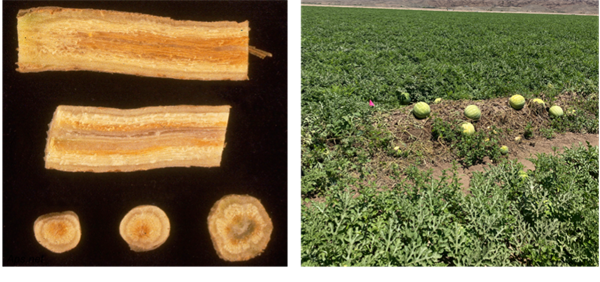Fusarium wilt of watermelon, caused by Fusarium oxysporum f. sp. niveum, is one of the oldest described Fusarium wilt diseases and the most economically important disease of watermelon worldwide. It occurs on every continent except Antarctica and new races of the pathogen continue to impact production in many areas around the world. Long-term survival of the pathogen in the soil and the evolution of new races make management of Fusarium wilt difficult.
In 2022, we had a lot of watermelon fields infected with Fusarium from Winterhaven to Yuma, Wellton, and Mohawk Valley. Rain, and overwatering of fields when plants set fruits might have contributed to the disease development. It is always a good idea to look out for any potential diseases that might occur this year!
Symptoms of Fusarium can sometimes be confused with water deficiency, even though there is plenty of water in the field. In Yuma valley we have seen fusarium problem in some overwatered fields.
Initial symptoms often include a dull, gray green appearance of leaves that precedes a loss of turgor pressure and wilting. Wilting is followed by a yellowing of the leaves and finally necrosis. The wilting generally starts with the older leaves and progresses to the younger foliage. Under conditions of high inoculum density or a very susceptible host, the entire plant may wilt and die within a short time. Affected plants that do not die are often stunted and have considerably reduced yields. Under high inoculum pressure, seedlings may damp off as they emerge from the soil.
Initial infection of seedlings usually occurs from chlamydospores (resting structure) that have overwintered in the soil. Chlamydospores germinate and produce infection hyphae that penetrate the root cortex, often where the lateral roots emerge. Infection may be enhanced by wounds or damage to the roots. The fungus colonizes the root cortex and soon invades the xylem tissue, where it produces more mycelia and microconidia. Consequently, the fungus becomes systemic and often can be isolated from tissue well away from the roots. The vascular damage we see in the roots is the defense mechanism of the plant to impede the movement of pathogen.
Disease management include planting clean seeds/transplants, use of resistant cultivars, crop rotation, soil fumigation, soil solarization, grafting, biological control. An integrated approach utilizing two or more methods is required for successful disease management.






